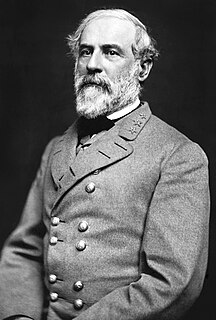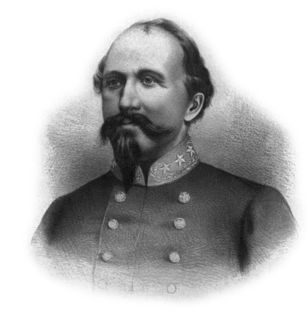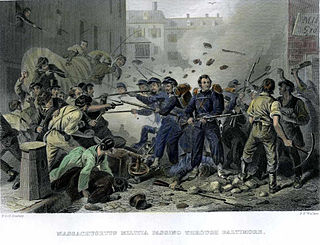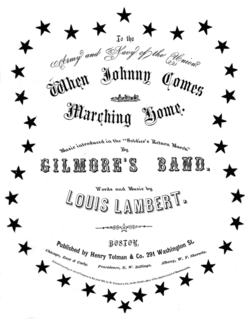This article is being considered for deletion in accordance with Wikipedia's deletion policy. Please share your thoughts on the matter at this article's deletion discussion page. |
The first USS Pilgrim, a canal boat, was purchased during the American Civil War by the Union Navy at Philadelphia, Pennsylvania, 18 July 1864, laden with stone, and sent via Baltimore, Maryland, to the James River to be sunk on the bar at Trent's Reach, Virginia, to protect General Ulysses S. Grant’s troops from Confederate attack by water.

The American Civil War was a civil war in the United States between the Union and the Confederacy. The central cause of the war was the status of slavery, especially the expansion of slavery into territories acquired as a result of the Louisiana Purchase and the Mexican–American War. On the eve of the Civil War in 1860, four million of the 32 million Americans (~13%) were enslaved black people, almost all in the South.

Robert Edward Lee was a Confederate general who served the Confederate States of America in the American Civil War, during which he was appointed the overall commander of the Confederate States Army. He led the Army of Northern Virginia, the Confederacy's most powerful army, from 1862 until its surrender in 1865. During the war, Lee earned a solid reputation as a skilled tactician, for which he was revered by his officers and men as well as respected and feared by his adversaries in the Union Army.
1862 (MDCCCLXII) was a common year starting on Wednesday of the Gregorian calendar and a common year starting on Monday of the Julian calendar, the 1862nd year of the Common Era (CE) and Anno Domini (AD) designations, the 862nd year of the 2nd millennium, the 62nd year of the 19th century, and the 3rd year of the 1860s decade. As of the start of 1862, the Gregorian calendar was 12 days ahead of the Julian calendar, which remained in localized use until 1923.

Joseph Hooker was an American Civil War general for the Union, chiefly remembered for his decisive defeat by Confederate General Robert E. Lee at the Battle of Chancellorsville in 1863.

The First Battle of Bull Run, also known as the Battle of First Manassas, was the first major battle of the American Civil War. The battle was fought on July 21, 1861, in Prince William County, Virginia, just north of the city of Manassas and about 30 miles west-southwest of Washington, D.C. The Union's forces were slow in positioning themselves, allowing Confederate reinforcements time to arrive by rail. Each side had about 18,000 poorly trained and poorly led troops. It was a Confederate victory, followed by a disorganized retreat of the Union forces.

John Hunt Morgan was an American soldier who served as a Confederate general in the American Civil War of 1861–1865.

The Battle of Stones River, also known as the Second Battle of Murfreesboro, was a battle fought from December 31, 1862, to January 2, 1863, in Middle Tennessee, as the culmination of the Stones River Campaign in the Western Theater of the American Civil War. Of the major battles of the war, Stones River had the highest percentage of casualties on both sides. Although the battle itself was inconclusive, the Union Army's repulse of two Confederate attacks and the subsequent Confederate withdrawal were a much-needed boost to Union morale after the defeat at the Battle of Fredericksburg, and it dashed Confederate aspirations for control of Middle Tennessee.

During the American Civil War, the Union, also known as the North, referred to the United States led by President Abraham Lincoln. It was opposed by the secessionist Confederate States of America (CSA), informally called "the Confederacy" or "the South". The Union is named after its declared goal of preserving the United States as a constitutional union. "Union" is used in the U.S. Constitution to refer to the founding formation of the people, and to the states in union. In the context of the Civil War, it has also often been used as a synonym for "the northern states loyal to the United States government;" in this meaning, the Union consisted of 20 free states and five border states.

The Baltimore riot of 1861 was a civil conflict on Friday, April 19, 1861, on Pratt Street, in Baltimore, Maryland. It occurred between antiwar "Copperhead" Democrats and other Southern/Confederate sympathizers on one side, and on the other, members of Massachusetts and Pennsylvania state militia regiments en route to the national capital at Washington who had been called up for federal service. The fighting began at the President Street Station, spreading throughout President Street and subsequently to Howard Street, where it ended at the Camden Street Station. The riot produced the first deaths by hostile action in the American Civil War and is often called the "first bloodshed of the Civil War".

The Army of the Cumberland was one of the principal Union armies in the Western Theater during the American Civil War. It was originally known as the Army of the Ohio.

"When Johnny Comes Marching Home", sometimes "When Johnny Comes Marching Home Again", is a popular song from the American Civil War that expressed people's longing for the return of their friends and relatives who were fighting in the war.

The Battle of Ball's Bluff was an early battle of the American Civil War fought in Loudoun County, Virginia, on October 21, 1861, in which Union Army forces under Major General George B. McClellan suffered a humiliating defeat.

Charles Pomeroy Stone was a career United States Army officer, civil engineer, and surveyor. He fought with distinction in the Mexican–American War, earning two brevet promotions for his performance in the conflict. After resigning and surveying for the Mexican Government, he returned to the U.S. Army to fight in the American Civil War.
Stones River National Battlefield, a 570-acre (2.3 km2) park along the Stones River in Rutherford County, Tennessee, three miles (5 km) northwest of Murfreesboro and twenty-eight miles southeast of Nashville, memorializes the Battle of Stones River. This key battle of the American Civil War occurred on December 31, 1862 and January 2, 1863, and resulted in a strategic Union victory.

George Hull Ward was a soldier and Union officer in the American Civil War.

Roy Stone was an American soldier, civil engineer, and inventor. He served in the American Civil War, distinguishing himself during the Battle of Gettysburg, and took part in the Spanish–American War. He pursued a civil engineering career in a peacetime and became in 1893 the first head of the Office of Road Inquiry, which was the Federal Highway Administration's predecessor.

As a fervently abolitionist and strongly Republican state, Maine contributed a higher proportion of its citizens to the Union armies than any other, as well as supplying extensive equipment and stores. Although no land battles were fought in Maine, the Battle of Portland Harbor (1863) saw a southern raiding party thwarted in its attempt to capture a revenue cutter.

The New England state of Connecticut played an important role in the American Civil War, providing arms, equipment, technology, money, supplies, and manpower for the Union Army, as well as the Union Navy. Several Connecticut politicians played significant roles in the Federal government and helped shape its policies during the war and the subsequent Reconstruction.
This article incorporates text from the public domain Dictionary of American Naval Fighting Ships .The entry can be found here.